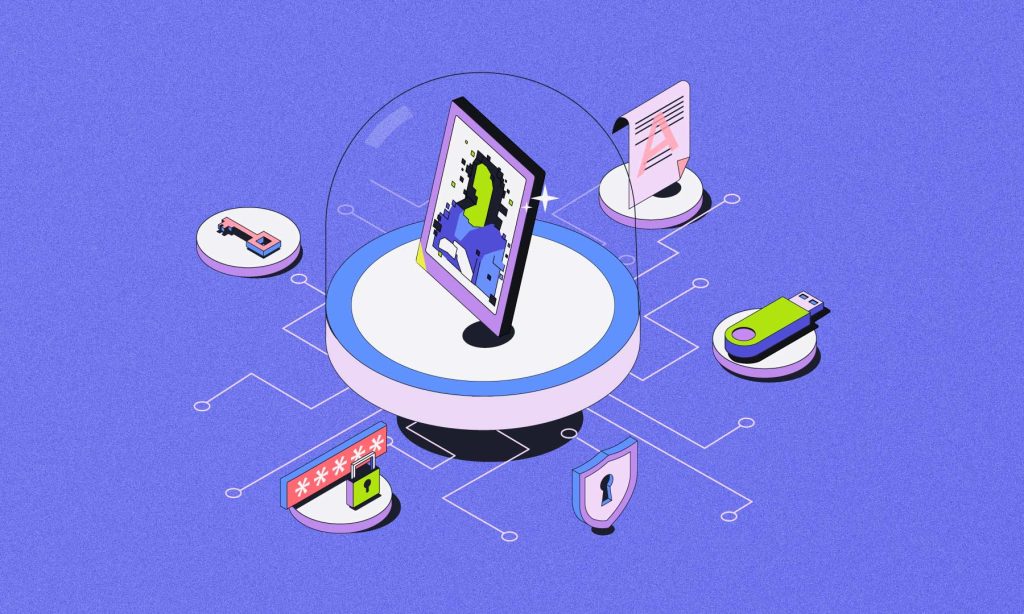Non-Fungible Tokens (NFTs) have become increasingly popular in the art world. Understandably so. After all, it is a way to sell your digital art. Because it ensures that nobody else can claim ownership over it, and you can keep earning royalties each time it is sold. However, with the rise of NFTs comes the risk of theft and fraud. So if you’re choosing this route, knowing how to protect your artwork from NFT theft is important.
What are NFTs?
Let’s start with a quick recap. Do you remember what NFTs are? They are unique digital assets that live on the blockchain. Blockchain technology ensures that anyone on the chain can verify the NFT’s ownership and authenticity.
The value of an NFT is derived from the rarity of the asset it represents. It can represent various digital assets, such as images, videos, and audio files.
NFTs have gained popularity in art as a way to sell and collect digital artwork.
Ways to protect your artwork from NFT theft
As the popularity of NFTs skyrockets in the art world as a way to sell and authenticate digital artwork, the risk of theft becomes more apparent. But there are some ways to protect your artwork from NFT theft. A few are listed below.
- Using a reputable NFT marketplace: Make sure you use a well-known and reputable NFT marketplace to sell your artwork. Good platforms usually have security measures in place to protect against theft.
- Keep your private key safe: The private key is essentially like your password. It allows you to access and transfer your NFT. Keep it safe and secure—preferably in a hardware wallet.
- Monitor for unauthorized use: Regularly check for unauthorized use of your artwork. You can do this through reverse image searches or blockchain analytics tools.
In addition to these basic steps, you should try the following.
Store NFTs in a custodial wallet.
Regarding storing your NFTs, there are two options: custodial and non-custodial wallets. A third-party service manages custodial wallets. On the other hand, non-custodial wallets give you complete control over your private key. Here’s why you might want to opt for a custodial wallet:
- Convenience: Custodial wallets are generally easier to use than non-custodial ones. That makes them a good option for beginners.
- Security: Custodial wallets often have robust security measures to protect your NFTs from theft or hacking.
- Insurance: Some custodial wallets offer insurance to cover the value of your NFTs in case of loss or theft.
- Third-party management: You don’t have to worry about managing your private key or keeping it safe.
Copyright your art.
Copyrighting your art is one of the most effective ways to protect it from NFT theft. Doing this allows you to prevent others from reproducing, distributing, or displaying your artwork without your permission.
You must register with your country’s copyright authority to copyright your artwork. In India, that would be the Copyright Office.
Add a watermark.
Adding a visible watermark to your digital artwork can help deter thieves. Watermarks make it more difficult for others to pass off your artwork as their own. They may be an image or text overlay over your artwork. Customizing them to include your name or logo makes it easy for others to identify your work.
While a watermark does not completely prevent NFT theft, it can make it more difficult for others to profit from your artwork without your permission.
Beware of fake extensions or spyware.
Be aware of fake browser extensions or spyware on your computer at all times. These can be used to steal your NFTs. Fake browser extensions may even mimic popular NFT marketplaces or wallets. They may do this to trick you into providing your private keys or seed phrases.
Spyware, too, can be used to monitor your computer activity. Hackers use it to access the digital assets of others.
Only use reputable marketplaces and wallets to avoid falling victim to these types of attacks. And keep your antivirus software up to date.
Conclusion
In conclusion, protecting your artwork from NFT theft is crucial. It helps maintain its integrity and value. By using reputable NFT marketplaces, keeping your private key safe, adding watermarks, copyrighting your art, storing NFTs in a custodial wallet, and being aware of fake extensions and spyware, you can significantly reduce the risk of NFT theft.
FAQs
What is an NFT?
NFT stands for Non-Fungible Token. This digital asset represents ownership of unique pieces of content, such as artwork, music, or videos.
How can I store my NFTs securely?
You can store your NFTs securely by using a custodial wallet. This is a type of digital wallet managed by a third-party service provider. Such wallets tend to have robust security measures in place.
What is a watermark?
A watermark is a visible mark or logo superimposed on the artwork. It indicates the ownership of the original creator.
How can I copyright my artwork?
Depending on your location, you can copyright your artwork by registering it with the Copyright Office or with an international copyright organization.
What should I do if my NFT is stolen?
If your NFT is stolen, you should immediately contact the storage platform you were using to report the theft. Provide any relevant information or documentation you have. The transaction ID and proof of ownership will help build your case. The platform may help you recover the stolen NFT or take action against the thief.
If the theft occurred on a blockchain, you might also be able to track the NFT and even identify the thief. Fingers crossed!
What are some effective strategies to safeguard NFT artwork from theft?
Use strong wallet security, mint on trusted platforms, embed watermarks and metadata, monitor unauthorized use, consider insurance, and educate yourself about copyright laws to safeguard NFT artwork from theft.








